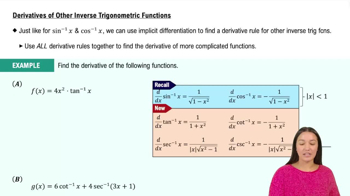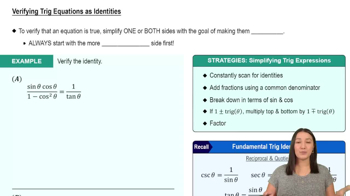Evaluating inverse trigonometric functions Without using a calculator, evaluate the following expressions.
Table of contents
- 0. Functions7h 54m
- Introduction to Functions16m
- Piecewise Functions10m
- Properties of Functions9m
- Common Functions1h 8m
- Transformations5m
- Combining Functions27m
- Exponent rules32m
- Exponential Functions28m
- Logarithmic Functions24m
- Properties of Logarithms36m
- Exponential & Logarithmic Equations35m
- Introduction to Trigonometric Functions38m
- Graphs of Trigonometric Functions44m
- Trigonometric Identities47m
- Inverse Trigonometric Functions48m
- 1. Limits and Continuity2h 2m
- 2. Intro to Derivatives1h 33m
- 3. Techniques of Differentiation3h 18m
- 4. Applications of Derivatives2h 38m
- 5. Graphical Applications of Derivatives6h 2m
- 6. Derivatives of Inverse, Exponential, & Logarithmic Functions2h 37m
- 7. Antiderivatives & Indefinite Integrals1h 26m
- 8. Definite Integrals4h 44m
- 9. Graphical Applications of Integrals2h 27m
- 10. Physics Applications of Integrals 3h 16m
- 11. Integrals of Inverse, Exponential, & Logarithmic Functions2h 31m
- 12. Techniques of Integration7h 41m
- 13. Intro to Differential Equations2h 55m
- 14. Sequences & Series5h 36m
- 15. Power Series2h 19m
- 16. Parametric Equations & Polar Coordinates7h 58m
0. Functions
Inverse Trigonometric Functions
Problem 89
Textbook Question
Express θ in terms of x using the inverse sine, inverse tangent, and inverse secant functions. <IMAGE>
 Verified step by step guidance
Verified step by step guidance1
Identify the trigonometric relationships given in the problem. Typically, this involves recognizing the sides of a right triangle or the coordinates of a point on the unit circle.
Express the angle \( \theta \) in terms of \( x \) using the inverse sine function. Recall that \( \theta = \sin^{-1}(x) \) when \( x \) is the opposite side over the hypotenuse in a right triangle.
Express the angle \( \theta \) in terms of \( x \) using the inverse tangent function. Remember that \( \theta = \tan^{-1}(x) \) when \( x \) is the opposite side over the adjacent side in a right triangle.
Express the angle \( \theta \) in terms of \( x \) using the inverse secant function. Note that \( \theta = \sec^{-1}(x) \) when \( x \) is the hypotenuse over the adjacent side in a right triangle.
Combine these expressions to find a consistent expression for \( \theta \) in terms of \( x \) using the given inverse trigonometric functions. Ensure that the domain and range of each function are considered to maintain validity.
 Verified video answer for a similar problem:
Verified video answer for a similar problem:This video solution was recommended by our tutors as helpful for the problem above
Video duration:
7mPlay a video:
Was this helpful?
Key Concepts
Here are the essential concepts you must grasp in order to answer the question correctly.
Inverse Trigonometric Functions
Inverse trigonometric functions, such as arcsin, arctan, and arcsec, are used to find angles when the values of the trigonometric ratios are known. For example, if sin(θ) = x, then θ can be expressed as θ = arcsin(x). These functions are essential for expressing angles in terms of their corresponding ratios, allowing for the conversion between angle measures and their sine, tangent, or secant values.
Recommended video:

Derivatives of Other Inverse Trigonometric Functions
Trigonometric Identities
Trigonometric identities are equations that involve trigonometric functions and are true for all values of the variables involved. Key identities include the Pythagorean identity, sin²(θ) + cos²(θ) = 1, and the definitions of tangent and secant in terms of sine and cosine. Understanding these identities is crucial for manipulating and simplifying expressions involving trigonometric functions, especially when expressing one function in terms of another.
Recommended video:

Verifying Trig Equations as Identities
Domain and Range of Inverse Functions
The domain and range of inverse trigonometric functions are critical for determining valid inputs and outputs. For instance, the domain of arcsin is [-1, 1] and its range is [-π/2, π/2]. Knowing these constraints helps ensure that the expressions derived from inverse functions are valid and meaningful, particularly when solving for angles in terms of other variables.
Recommended video:

Finding the Domain and Range of a Graph
Related Videos
Related Practice
Textbook Question


